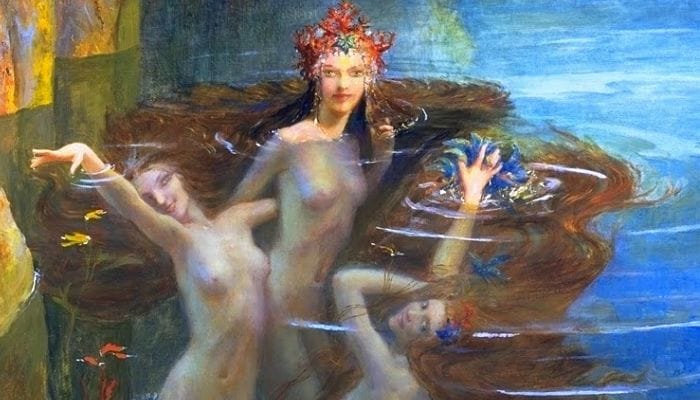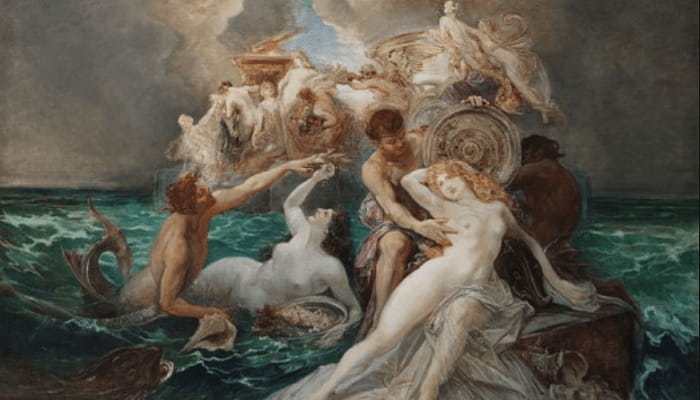The Nereids were fifty nymphs, daughters of Nereus, the old man of the sea. They were maidens of the sea’s riches and protectors of sailors and fishermen, who came to the aid of those in distress. Each of them represented various aspects of the sea, from brine to sea foam, sand, rocks, waves, and currents, as well as the various skills possessed by sailors.
What is a Nereid?

The Nereids are a group of fifty sea nymphs, daughters of Nereus and Doris, who are famous for their beauty and sweetness. Together, they represent all that is good about the ocean, from its sparkling waves to its swift currents and abundance of fish.
They lived with their elderly father in a silver grotto at the bottom of the Aegean Sea. The Nereid Thetis was their unofficial leader and Amphitrite was the queen of Poseidon.
The Nereids were depicted in ancient art as beautiful young maidens, sometimes running with small dolphins or fishing with their hands, or riding on the backs of dolphins, hippopotamuses (seahorses), and other sea creatures. The name Nereids means “Daughters of Nereus” but also “the Wet Ones” from nêros, the Greek word for “wet.”
Description
Like the nymphs of fresh water and earth, the Nereids are exquisitely beautiful maidens with pink skin and long, flowing hair. No two Nereids are exactly alike, but they can always be identified by the tokens of their ocean home: a red coral comb that holds their curls in place or a starfish clinging to their tunics.
The daughters of the ocean are friendly to all its creatures; most of the time, you’ll find them riding dolphins or cuddling with seahorses. Occasionally, the maidens themselves are seen with graceful, fish-like tails.
Special abilities
Generally, Nereids are as sweet-tempered as they are beautiful. The fifty are famous for their soft, silky voices and light-footed dancing, and they will gladly entertain a weary traveler in their palace of silver and gold beneath the sea. However, they are not as dangerous as mermaids. Instead of seducing and trapping sailors, they guide ships and calm the seas.
If you manage to anger one of these serene maidens, you will have to fight a battle. A Nereid’s greatest strength is her family; if you insult one of these maidens, all fifty will come down on you. Nereus, Poseidon, and even Zeus tend to support the sea nymphs as well, so you can expect to be greeted with horrible storms and angry sea monsters if you dare mess with a Nereid.
Each of the sisters has her own special touch when it comes to the ocean. For example, Galatea conjures up sea foam, while Kymo creates waves. Neso rules the islands, Speio dwells in sea caves, and Tethys controls the spawning of fish.
Origins
The fifty Nereids share a father, Nereus, who is often called “the Old Man of the Sea. “ Nereus was born directly from the Sea and the Earth. His power is ancient, even predating the rise of the Olympian gods, but he takes a subordinate position to the other gods. Instead of joining them on Olympus, he maintains his own magnificent palace in the Aegean Sea, where he is attended by his charming daughters.
In addition to his palace, Nereus also shares his noble spirit with his daughters. He is famous for his honesty and benevolence, and the gentle Nereids have undoubtedly inherited his temperament. The mother of all Nereids is Doris, a sea nymph who was born to a pair of ocean Titans. She passed on to her daughters her poetic beauty and her responsibility to keep the ocean rich and hospitable.
The Nereids can also count Poseidon, the God of the Ocean, as a strong ally. The beautiful maidens often travel with Poseidon, adding a little more style to his entourage. In return, Poseidon defends their honor against any adversary or unworthy suitor.
Famous myths

The Sacrifice of Andromeda
Queen Cassiopeia was famous for her beauty and vanity. For years, she and her husband ruled the kingdom of Ethiopia with great style, but when the queen’s vanity led her to boast that her daughter, Andromeda, was more beautiful than the Nereids, she brought the wrath of the gods down upon her unfortunate kingdom.
Poseidon was offended when he heard Cassiopeia disparaging the beauty of his beloved Nereids. For her sake, he asked Zeus for permission to unleash a hideous sea monster, Cetus, on the coast of Ethiopia. After Cetus had reduced much of the kingdom to ruins, the desperate king asked an oracle how the beast could be stopped. The king received a horrible answer: he must sacrifice his innocent daughter, Andromeda, to the monster.
With a heavy heart, the king sent Andromeda to the seashore, where she was stripped naked and chained to a rock. Just as the monster emerged from the ocean to claim its prize, Perseus came to the maiden’s rescue. He killed the monster and took the beautiful Andromeda (though not as beautiful as a Nereid) as his wife.
The Test of Theseus
Shortly before his legendary attack on the Minotaur, Theseus was subjected to an even more complicated test. He had just arrived in Crete, along with six other boys and seven girls who were supposed to be sacrificed to the Minotaur. Minos, the king of Crete, came up with a new idea when he noticed the beauty of one of these young women; he decided that he would take her to his own room, instead of sending her to the deadly labyrinth, where the Minotaur awaited her.
Theseus opposed King Minos, declaring that he was the son of Poseidon and that he would not allow a young lady to be wrongfully used. Minos simply laughed at Theseus. Then he took a gold ring from his finger and threw it into the ocean, telling Theseus to retrieve it if he was truly the son of Poseidon.
Without hesitation, Theseus jumped into the ocean. A swarm of dolphins appeared around him and guided him under the waves and into the sparkling depths of the ocean. There he found a palace of overwhelming beauty, and the Nereids, with skin glowing like fire and feet moving like liquid, rushed out to meet him. After a glorious feast, the Nereids sent him back with Minos’ ring and a crown studded with precious stones to prove that he was indeed the son of Poseidon.
The happy marriage of Amphitrite
One of the most beautiful Nereids, Amphitrite, attracted more than a friendly glance from Poseidon. The god loved her more than all his sisters, and eventually, he proposed marriage to her. At first, Amphitrite was frightened by the concept of marriage. She eluded Poseidon by fleeing from one grotto to another in the depths of the ocean. Fortunately, the god Delphin was a better swimmer than Poseidon. He found Amphitrite and convinced her to return to her future husband. They were married, and Amphitrite lived a life of splendor as Queen of the Sea.
The unhappy marriage of Thetis
One day, some of the Nereid sisters were frolicking together on the seashore, playing one of their charming games. A man, Peleus, saw them and was overcome with the desire to make a Nereid his wife. He joined in their game and grabbed the beautiful Thetis. Although she tried to change her form in various ways, Peleus still held on to her. Finally, exhausted, she agreed to marry him, but she was not happy about it, and neither were any of her sisters.
An elaborate wedding, with beautiful water flowers and enchanting music, was held for Peleus and Thetis, but Thetis’ heart remained bitter. Her sisters accompanied her to the wedding, all mourning for her, and the bride herself wept behind her veil. Despite hating her husband, Thetis loved the son they had borne, Achilles. She tried to bless him with immortality, told him of a prophecy that he would be greater than his father, hid him during the first half of the Trojan War, and gave him special armor to fight his arch-enemy, Hector.
The Argonauts and the Wandering Rocks
Under the orders of the goddess Hera, the Nereids agreed to help the Argonauts on their sea voyage, even though they were still bitter enemies of Peleus, who had forced Thetis to marry him.
First, Thetis approached the Argonauts’ ship, which had been stuck on the beach at Aia for days. She only appeared to her husband, telling him to prepare the ship for a dangerous journey the next day. She and the other sea nymphs would guide the ship through this journey, but he must not tell any of his companions, or she would be angrier than ever with him.
As ordered, the Argonauts prepared to set sail, and the next day, Thetis appeared again. This time, she began to push the ship, guiding it through the water. Soon, the other nymphs began to leap around the ship like a crowd of dolphins. The ship approached a group of dangerous rocks, but with Thetis guiding them and her sisters protecting them, they made it safely through the rocks.
The Nereids in Greek and Roman culture

The Nereids were revered in Greek culture. Their legendary beauty earned them a place in the finest Greek artwork, and in coastal cities, they were even worshipped as deities. The daughters of the sea play a role in some of the most important literary works of ancient Greece, such as The Iliad, The Argonauts, and The Golden Fleece. They also abound in minor poetry. Mosaic shrines were built to honor the beautiful sea nymphs.
Images of them were printed on silver and gold coins, even carved into the faces of precious stones for elite ladies to wear as jewelry. Like many of the other gods and demigods of Greek culture, the Nereids were passed on to the Romans, who were equally fascinated by them.
Modern Use
Today, the term “nereid” has largely fallen out of use. When referring to the Nereids, they are poorly distinguished from other nymphs and fairy-like creatures. In honor of ancient Greek mythology, one of the moons orbiting Neptune (a planet named after Neptune or Poseidon) is called Nereid.

